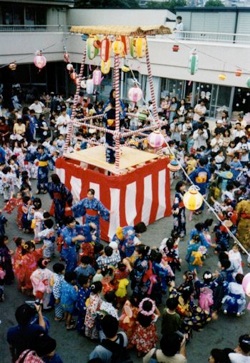What is ‘Obon’?






Festival of the Dead
Obon is a Buddhist festival that has been practised since Buddhism came to Japan around 672 AD.

Japanese Buddhism includes ancestor worship as it is believed that the dead people are on their way to becoming gods (hotoke-sama). It is usually practised on 14-16th August each year though some regions have their Obon festivals from July.
The original meaning is fairly grim. Obon comes from the word Urabon-e (hanging upside down in agony in hell according to Buddhist belief). For 3 days the lid of hell is opened and the suffering spirits of those who've died are allowed out to go back to their homes on earth. So Obon is to welcome them back. In most villages and communities a large platform is set up with red and white banners and lanterns and from about 6-10 pm traditional Japanese music is played, and people in summer kimonos (yukatas) dance round the platform in a slow traditional dance.
Most modern Japanese do not think of the Buddhist meaning but regard it as a time to celebrate, mix with friends, dress up and buy food (yakitori- chicken kebabs etc) and drink from the stalls. Children in colourful yukatas are a pretty sight. There may also be singing performances and firework displays. Roads and trains will be busy during Obon as most people will try to return to their home towns to be with their families. Many people will also go their family tombs and local temples to pray to their dead. Many homes have a Buddhist altar and particular attention is paid to ancestors during Obon. On the last night of Obon little lanterns are often floated down rivers to say farewell to the departing spirits. Offerings such as cake, friut and drink are left overnight at the graves. Some times a fire is lit (Okuribi= sending off fire). Local customs vary.


